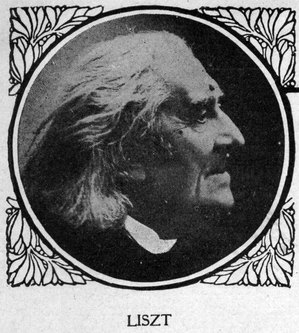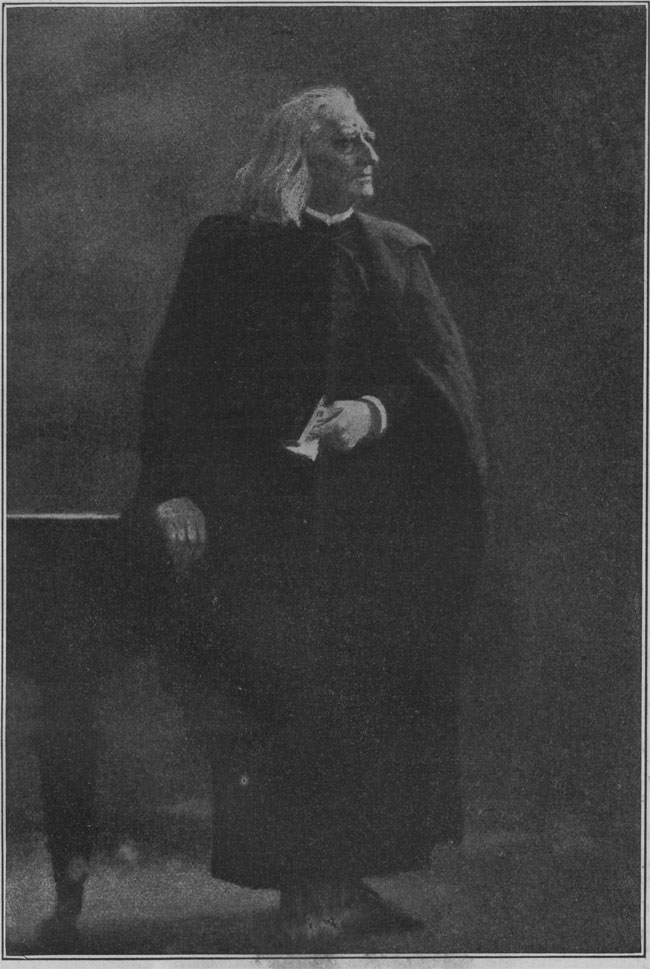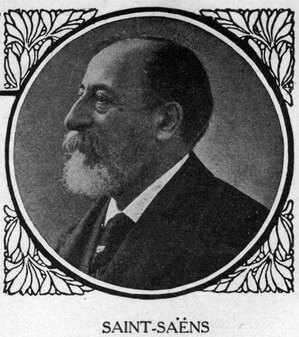By CAMILLE SAINT-SAËNS
Translated expressly for THE ETUDE By V. J. HILL
[Editor’s Note.—The Symphonic Poem as a musical form or type has evidently been gaining in popularity during the comparatively short time since the death of the great Hungarian composer who first conceived the idea of breaking away from the more stilted symphony. The immense success of the symphonic poems of Strauss and other modern composers shows the wisdom and prophetic vision of Franz Liszt. Most of the symphonic poems of Franz Liszt are available for the use of more advanced readers of The Etude through duet arrangements These are no more difficult to perform in this form than are some of the easier nieces of Liszt. “Les Preludes” has always been a favorite. The addition of a number of this kind as a final duet adds greatly to the attractiveness of a pupil’s recital.]
 Persons interested in things musical may perhaps recall a concert given some years ago in the hall of the Theatre Italien under the direction of the author of this article. The program was composed entirely of the orchestral works of Franz Liszt, whom the world persists in calling a great pianist, in order to avoid acknowledging him as one of the greatest composers of our time. This concert was considerably discussed in the musical world, strictly speaking, and in a lesser degree by the general public. Liszt as a composer seemed to many to be the equal of Ingres as a violinist, or Thiers as an astronomer. However, the public, who would have come in throngs to hear Liszt play ten bars on the piano, as might be expected, manifested very little desire to hear the Dante Symphony, the Bergers a la creche and Les Mages, symphonic parts of Christus, and other compositions which, coming from one less illustrious, but playing the piano fairly well, would have surely aroused some curiosity. We must also state that the concert was not well advertised. While the “Spanish Student” monopolized all the advertising space and posters possible, the Liszt concert had to be satisfied with a brief notice and could not, at any price, take its place among the theatre notices.
Persons interested in things musical may perhaps recall a concert given some years ago in the hall of the Theatre Italien under the direction of the author of this article. The program was composed entirely of the orchestral works of Franz Liszt, whom the world persists in calling a great pianist, in order to avoid acknowledging him as one of the greatest composers of our time. This concert was considerably discussed in the musical world, strictly speaking, and in a lesser degree by the general public. Liszt as a composer seemed to many to be the equal of Ingres as a violinist, or Thiers as an astronomer. However, the public, who would have come in throngs to hear Liszt play ten bars on the piano, as might be expected, manifested very little desire to hear the Dante Symphony, the Bergers a la creche and Les Mages, symphonic parts of Christus, and other compositions which, coming from one less illustrious, but playing the piano fairly well, would have surely aroused some curiosity. We must also state that the concert was not well advertised. While the “Spanish Student” monopolized all the advertising space and posters possible, the Liszt concert had to be satisfied with a brief notice and could not, at any price, take its place among the theatre notices.Several days later, a pianist giving a concert at the Italien, obtained this favor. Theatres surely offer inexplicable mysteries to simple mortals. The name of Liszt appeared here and there in large type on the top row of certain posters, where the human eye could see it only by the aid of a telescope. But, nevertheless, our concert was given, and not to an empty hall. The musical press, at our appeal, kindly assisted; but the importance of the works on which they were invited to express an opinion seemed to escape them entirely. They considered, in general, that the music of Liszt was well written, free from certain peculiarities they expected to find in it, and that it did not lack a certain charm. That was all.
If such had been my opinion of the works of Liszt, I certainly would not have taken the trouble to gather together a large orchestra and rehearse two weeks for a concert. Moreover, I would like to say a few words of these works, so little known, whose future seems so bright. It is not long since that orchestral music was confined to but two forms—the symphony and the overture. Haydn, Mozart and Beethoven had never written anything else; who would have dared to do other than they? Neither Weber, Mendelssohn, Schubert nor Schumann. Liszt did dare.
In art, to dare is the gravest thing in the world. In theory, I grant, nothing is more simple. There are no laws governing the arts; and artists are free to do as they will. Who can prevent them?
In practice, everything prevents it, the world and the artists themselves. New forms demanded and sought, inspire fear and repulsion, at least in appearance. To accept new forms, to penetrate into their meaning, requires mental effort, and there are few who care to make this effort. What people like is to languish in idleness and routine, even though they succumb to ennui and satiety.
Liszt understood that to introduce new forms, he must cause a necessity to be felt, in a word, produce a motive for them. He resolutely entered on the path which Beethoven, with the Pastoral and Choral Symphonies and Berlioz with the “Symphonie Fantastique” and “Harold in Italy” had suggested rather than opened, for they had enlarged the compass of the symphony, but had not transformed it, and it was Liszt who created the symphonic poem.
This brilliant and fecund creation will be to posterity one of Liszt’s greatest titles to glory, and when time shall have effaced the luminous trace of this greatest pianist who has ever lived, it will inscribe on the roll of honor the name of the emancipator of instrumental music.
Liszt not only introduced into the musical world the symphonic poem, he developed it himself and in his own twelve poems he has shown the chief forms in which it can be clothed.
Before taking up the works themselves, let us consider the form of which it is the soul, the principal of program music.
To many, program music is a necessarily inferior genre. Much has been written on this subject that cannot be understood.
Is the music, in itself, good or bad? That is the point.
The fact of its being “program” or not makes it neither better nor worse.
It is exactly the same in painting, where the subject of the picture, which is everything to the vulgar mind, is nothing or little to the artist
The reproach against music, of expressing nothing in itself without the aid of words, applies equally to painting.
A picture will never represent Adam and Eve to a spectator who does not know the Bible; it could represent to them nothing other than a man and woman in a garden. Nevertheless, the spectator or listener lends himself very well to this supercherie which consists in adding to the pleasure of the eye or ear, the interest or emotion of the subject. There is no reason for refusing him this pleasure; furthermore, there is no reason for according it to him. Liberty is absolute; artists take advantage of this fact and are wise in so doing.
It is an incontestable fact that the public taste of the present days tends toward subject pictures and program music, and that public taste, at least in France, has drawn artistsin its train.
PROGRAM MUSIC.
To the artist, program music is only a pretext to enter upon new ways, and new effects demand new means, which, by the way, is very little desired by orchestra leaders and capelmeisters who, above all, love ease and tranquil existence. I should not be surprised to discover that the resistance to works of which we speak comes not from the public, but from orchestra leaders; little anxious to cope with the difficulties of every nature which they contain. However, I will not affirm it.
The compositions to which Liszt gave the name symphonic poem are twelve in number:
1. Ce qu’on entend sur la montagne, after Victor Hugo.2.Tasso, Lamento and Trionfo.3. Les Preludes, after Lamartine.4. Orphée.5. Prométhée.6. Mazeppa.7. Fest Klänge.8. Héroïde funebre.9. Hungaria.10. Hamlet.11. La bataille des Huns, after Kaulbach.12. L’idéal, after Schiller.
Liszt has also written the Dante and Faust symphonies, which are only symphonies in name, however, and in reality are symphonic poems in two and three parts, and two musical tableaux of equal grandeur, the Mephisto Waltz and and the Procession Nocturne from fragments of the poem Faust of Lenau.
We shall not discuss his oratorios and masses, piano works, which are abundant and which influence every writer for the piano, although unknown to himself. We limit ourselves to his orchestral works.
The symphonic poem in the form in which Liszt has given it to us, is ordinarily an ensemble of different movements depending on each other, and flowing from a principle ideal, blending into each other, and forming one composition. The plan of the musical poem thus understood may vary infinitely. To obtain a great unity, and at the same time the greatest variety possible, Liszt most often chooses a musical phrase, which he transforms by means of artifices of rhythm, to give it the most divers aspects and cause it to serve as an expression of the most varied sentiments. This is one of the usual methods of Richard Wagner, and, in my opinion, it is the only one common to the two composers. In style, in use of harmonic resources and instrumentation, they differ as widely as two contemporary artists could differ, and yet really belong to the same school.
TASSO.
The poem Tasso may be considered a type of the kind of composition which we are discussing. The principal theme is that sung some years ago by the gondoliers of Venice, and to which they recited stanzas of Jerusalem Delivered.
After an introduction describing the dementia of Tasso, and in which accents of sombre despair alternate with the diabolic shrieks, the plaintive melody unrolls with all the melancholy of the lagoons of Venice, from whence the author received it; and, suddenly transformed, it bursts into a short song of triumph A glimmer of reason traverses the mind of Tasso, which represents his future glory; then his memory returns; with a long crescendo, it seems that a vast curtain is lifted, and to the sounds of a minuet of supreme elegance, we see pass before our vision under the sumptuous arcades of the enchanted gardens of Ferrara, beautiful women of graceful mien, in rich attire, whose smiles forever haunt the soul of the poet,and the phrase of the lagoons unfolding in a new form, shows us the poet himself, whose tender melancholy contrasts in the most musically picturesque manner with these feminine coquetteries. But the vision becomes confused, the mind of Tasso is again obscured, and the hero expires in a last convulsion… . Then begins the splendid finale; the “trionfo” succeeds the “lamento;” the trumpets peal, the crowds throng to acclaim the genius they have scorned, and the plaintive passage changed into a song of victory, bursts with all the power at the command of the modern orchestra. Such is, in summing up, this beautiful composition which was played with such success at the Paseldoup concerts. It is not probable that the public grasped the poetic nuances of the work, which no explanatory note indicated; but the design of the composition is so clear, the different parts follow in contrast so wisely arranged, the charm of the melody is so preponderant, that the musical side alone suffices to make it a success.
LES PRELUDES.
As much might be said of the symphonic poem Les Preludes, after Lamartine, frequently appearing on posters as Prelude, which signifies nothing. The same melodic phrase here allures, now amorous, now pastoral, now warlike; a storm gathers, increases, bursts and dies away in the middle of the composition. The whole charms the listener, independently of the poetic and literary thought, which suffices to demonstrate the falseness of that assertion, that descriptive music becomes incomprehensible when one does not know the program, and consequently is not music. But how great is the charm, when to purely musical pleasure, is added that of the imagination, unhesitatingly entering on a new path, so easily giving idea to music, which it does, whatever may be said to the contrary. All the faculties of the mind are brought into play and to the same end. I can easily see that art will gain from this,I fail to see what it will lose.
That which art gains is not greater beauty, but a more vast field over which to exercise its power; it is a greater variety of form, and therefore, greater liberty. It seems to me this can not be despised.
Besides these poems of vast dimensions, Liszt has written shorter ones, Orphée, for example, in which we recognize passages of an allurement more tense or moderate, but which in no way resemble the various parts of Tasso, Les Preludes, Ce qui on entend sur la montagne, and yet the work is not like an overture, nor a portion of a symphony; it is truly a symphonic poem, a composition of a new order, in its style as well as its character.
It would be difficult to make the public understand why this vaporous and delicious composition, which seems improvised by the artist of genius on an instrument, giving it the multiple effects of the orchestra, is entitled Orphée. The idea of the poet-musician is entirely mystic, and is explained in a preface accompanying the score. It is on the frontier of program music and pure music, and the wise plan for the majority of listeners would be to abandon themselves without reflecting, to the musical charm of the work and the impressions it gives. Nothing could be more delicate, more exquisite.
MAZEPPA.
Mazeppa was first produced in the form of piano music, a heroic study, intimidating, almost inaccessible for any but Liszt, himself. In becoming a symphonic poem, Mazeppa is vastly enriched; its equivalent is not to be found, for disheveled frenzy, as it draws with it the violins, violas and violoncellos, as a released torrent draws blades of grass in its course. It is the subject of the enthusiasm of Madame Olga Janina, who, in a series of articles praising the symphonic poems, by the way, treating as “an old shoe” the Ninth Symphony of Beethoven, thus describes a musical phrase of Mazeppa:
“Unknown griefs, nameless anguish, indefinable suffering, strange anxieties, morbid caprice, fantastic depravity, in fact all that the depths of the human soul contain of love and bitterness, of light and darkness, is revealed by this gigantic song, with an exquisitely strange savor, expanding the limitations of musical language, translating the inexpressible thought, in the most vague and elusive form.”
I contend that no simple musical phrase, written by no matter whom, could answer such a description, but I agree perfectly wth (sic) Madame Janina when she says that Mazeppa is a masterpiece: “The imitation of the gallop of the horse is secondary, and not in the least realistic, as would be claimed by the enemies of descriptive music; the title indicates the subject, and that suffices to fix the direction of thought. In the midst of the furious course the orchestra brings to the fore, with intensity, the singing phrases which express so marvelously what they wish to convey. The horse occupies the space, but the interest is concentrated on the rider, the man who suffers and thinks. Toward the middle of the composition one feels the impression of immensity of space; horse and rider vanish on the limitless steppe, and the glimpse of the man is confused with the thousand details of the expanse. It is a marvelous orchestral effect. The stringed instruments, much divided, echo in the length of their scale rangea multitude of sound of all kinds, slurred staccato, pizzicato; col legno, and colarco, and from all this results a harmonic web of sound forming a kind of canvas, on which appears in the foreground, a plaintive and touching song. All ends with a Czech march of irresistible effect, to which Mazeppa comes forth as King.”





